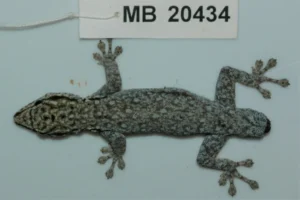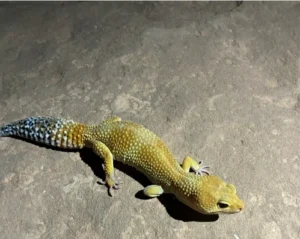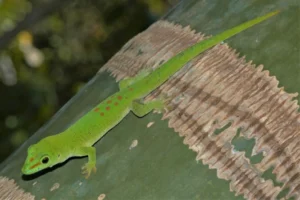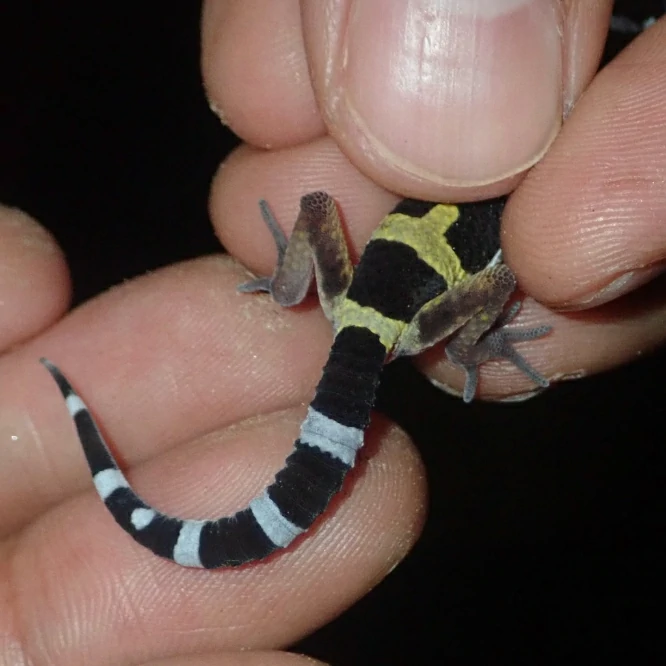Have you ever watched a gecko scurry across a wall or a tank and seen something wild?
One second it’s just sitting there, minding its own business, and the next, its tail suddenly comes off and starts wiggling on its own. The gecko darts away while the tail keeps moving like a little decoy.
It’s nature’s ultimate escape trick. But here’s the question: do all geckos actually drop their tails, or is this just something some species do?
No, not all geckos drop their tails, but many do. Tail-dropping, also called autotomy, is a defense mechanism that helps geckos survive predators. When a gecko senses danger, its tail can detach, giving it a few precious seconds to get away. The tail often continues to move on its own, distracting a predator while the gecko disappears into a hiding spot.
But here’s the catch: not every gecko can afford to lose its tail. Some need it for balance, communication, or fat storage, so letting it go can be too costly.
How Tail-Dropping Works
Geckos’ tails are built in a smart way. They have weak spots along the spine called fracture planes. Think of them like tiny pre-made break points that make the tail easy to drop.
When a gecko senses danger, muscles around the fracture planes tighten, letting the tail come off cleanly with hardly any bleeding. Then, almost like magic, the tail keeps moving for a few minutes.

That moving tail grabs the predator’s attention. A bird, snake, or bigger lizard might go for the squirming tail while the gecko slips away.
Basically, the gecko trades a tail for its life. Nature can be rough, but it’s also really clever.
Some geckos can drop their tails multiple times in life. Others can only do it once or twice because regrowing a tail uses a lot of energy.
Why Some Geckos Don’t Drop Their Tails
So if tail-dropping saves lives, why don’t all geckos do it? Well, tails aren’t just decoys, they’re storage spots, tools, and sometimes a way to send signals to other geckos.
-
Fat storage: Many geckos keep fat in their tails, especially ones that live in dry areas or go through seasons with little food. Losing the tail is like spending your emergency savings.
-
Balance and climbing: Tails help geckos climb walls, jump between branches, and stay steady while running. Without a tail, they’re more likely to stumble or fall.
-
Social signaling: Some geckos wave or twitch their tails to talk to mates or rivals.
Take leopard geckos, for example. They can drop their tails, but they rarely do. Their tail is their main fat storage, so losing it is a big setback.

On the other hand, day geckos and crested geckos almost never drop theirs. They use their tails for climbing and balance, and losing it could be dangerous in the wild.
How Geckos Regrow Their Tails
If a gecko drops its tail, don’t worry, most can grow it back. The new tail usually looks different from the old one. It might be shorter, darker, a little stubbier, or feel a bit different.
Regrowing a tail takes a lot of energy. You might notice your pet gecko eating more than usual afterward, it’s basically refueling to rebuild its lost tail.
Some geckos, like leopard geckos, can grow tails that look almost the same as the original. Others, like Mediterranean house geckos, might grow a tail that looks different but still works fine.
Either way, the new tail helps with balance and survival.
When Do Geckos Drop Their Tails?
Geckos don’t just toss their tails around for fun. Tail-dropping is usually a last-resort survival trick. Some common triggers are:
-
Predator encounters: Birds, snakes, bigger lizards, and even cats can make a gecko drop its tail.
-
Stress from handling: Especially in captivity, a sudden grab or rough handling can trigger a tail-drop.
-
Fights with other geckos: Territorial disputes sometimes lead to a lost tail.
-
Accidents: A tail can come off if it gets stuck or crushed in a tight space.
Even when these things happen, geckos usually try to hold onto their tails. It’s a survival tool, not something they give up lightly.
25 Gecko Species and Whether or Not They Drop Their Tails
Here are some gecko species and whether they drop their tails:
| Gecko Species | Drops Tail? | Notes |
|---|---|---|
| Leopard Gecko (Eublepharis macularius) | Yes | The tail stores fat, and a gecko might drop it if it gets really stressed, but it can grow back. |
| Crested Gecko (Correlophus ciliatus) | Yes (but it doesn’t really grow back in a meaningful way.) | The tail helps with balance and climbing, and if they lose it, it doesn’t really grow back properly. |
| Tokay Gecko (Gekko gecko) | Yes | They’re an aggressive species and will drop their tail if a predator grabs them. |
| Day Gecko (Genus Phelsuma) | Rarely | They use their tail for climbing, so losing it comes at a big cost. |
| Mediterranean House Gecko (Hemidactylus turcicus) | Yes | These geckos can drop their tail when they get stressed. |
| Gargoyle Gecko (Rhacodactylus auriculatus) | No (or very rarely) | hey use their tail for balance, and if they lose it, it barely grows back, or doesn’t at all. |
| New Caledonian Giant Gecko (Rhacodactylus leachianus) | Rarely | They have a prehensile tail that helps with climbing, so dropping it only happens as a last resort. |
| Marbled Leaf‑toed Gecko (Afrogecko porphyreus) | Yes | In lots of populations, most geckos have lost and regrown their tails at some point. |
| Yellow‑headed Dwarf Gecko (Lygodactylus luteopicturatus) | Yes | They drop their tail to escape predators, but losing it makes climbing harder. |
| Cape Dwarf Gecko (Lygodactylus capensis) | Yes | Dropping their tail is common, but it slows them down when climbing or escaping upwards. |
| Iraqi Eyelid Gecko (Eublepharis angramainyu) | Yes | This ground-dwelling eyelid gecko can drop its tail if needed. |
| Common House Gecko (Hemidactylus frenatus) | Yes | They’re found in lots of places, and dropping their tail has been seen; even tails that split in two. |
| African Fat‑Tailed Gecko (Hemitheconyx caudicinctus) | Yes | Like leopard geckos, their tail stores fat, and they can drop it if needed. |
| Japanese Gecko (Gekko japonicus) | Yes | They can drop their tail, but losing it also means losing the fat stored there. |
| Smooth Knob‑tailed Gecko (Nephrurus levis) | Yes (but limited) | Their tail is short and knob-shaped, and they can drop it, but not very often. |
| Anderson’s Eyelid Gecko (Eublepharis andersoni) | Yes | Like others in their family, they can drop their tail. |
| Gold‐Dust Day Gecko (Phelsuma laticauda) | Yes | This day gecko stores fat in its tail, and even though it lives in trees, it can still drop it if needed. |
| Mediterranean Gecko (Tarentola mauritanica) | Yes | Like house geckos, they can drop their tail, and it’s been seen in the wild. |
| Robust Forest Bavayia Gecko (Bavayia robusta) | Yes | This New Caledonian gecko has a long tail for climbing, and it can drop it if it has to. |
| Tokunoshima Leaf Toed Gecko (Goniurosaurus tokunoshimensis) | Yes | This leaf-toed gecko can drop its tail. |
| Mourning Gecko (Lepidodactylus lugubris) | Yes | This small tree-dwelling gecko can drop its tail, and it has been seen growing back. |
| Flying Gecko (Ptychozoon kuhlii) | Rarely | Their tail helps them glide or fan out, so they don’t drop it often because it’s too important. |
| Tokashiki Ground Gecko (Goniurosaurus tokashikiensis) | Yes | This ground-dwelling gecko can drop its tail, which is common in its group. |
| Cuban Cave Gecko (Sphaerodactylus scaber) | Yes | This small gecko group can drop their tails, though it hasn’t been studied much. |
| Tukku Gecko (Mniarogekko chahoua) | Rarely | This New Caledonian climbing gecko has a big tail for balance, so it doesn’t drop it very often. |
This table shows that while tail-dropping is common, it’s not something all geckos do. Each species has its own way of staying alive.
Gecko Tail-Dropping in the Wild
Picture a gecko on a branch in Madagascar. A hawk swoops down. The gecko senses danger and, in a split second, its tail comes off and starts wriggling across the leaves.

The hawk dives for the moving tail while the gecko disappears into a nearby tree. Seconds later, the gecko is safe, tail gone but alive.
In the deserts of Pakistan, a Persian spider gecko might drop its tail if a snake lunges. The tail keeps twitching, giving the gecko enough time to escape into a rocky crevice.
Even in cities, Mediterranean house geckos can use tail-dropping against cats or bigger lizards. Tail-dropping is basically nature’s “get out of trouble fast” trick.
Gecko Tail-Dropping in Captivity
Even at home, geckos can drop their tails, though it’s usually because of stress instead of predators. Pet geckos might drop a tail if:
-
They are handled roughly or suddenly
-
They are startled by loud noises or bright lights
-
They are housed with aggressive tank mates
If your gecko drops its tail at home, stay calm. The tail will wiggle for a few minutes, but the gecko is usually fine. Make sure it has a safe hiding spot while it calms down.
Over time, you’ll see the new tail slowly start to grow back if the species can regenerate it.
Fun Facts About Gecko Tails
-
Some geckos can drop their tail multiple times, though each time takes a lot of energy.
-
The tail is often used to communicate with other geckos. Tail waving can show aggression or attract mates.
-
Geckos in the wild rarely lose tails unless a predator forces them to. In captivity, stress is usually the main reason.
-
Young geckos grow tails faster than adults. Age matters!
Frequently Asked Questions
Can all geckos detach their tails?
No, not all geckos can drop their tails. Some species, like leopard geckos, can easily detach their tails to escape predators, while others, like crested geckos, either don’t drop them or can’t regrow them properly.
Why do some geckos drop their tails while others don’t?
Tail dropping, or autotomy, is a defense mechanism. Geckos that rely on it live in areas with more predators, so it helps them escape.
Species that climb carefully or use their tails for balance or fat storage often don’t drop them, because losing a tail could hurt more than help.
Which gecko species are most likely to drop their tails?
Leopard geckos, tokay geckos, and many house geckos are among the species most likely to detach their tails when stressed or threatened. These geckos often regrow a new tail afterward.
Why do some geckos never drop their tails?
Some species, like crested geckos or day geckos, never drop their tails because they need them for climbing, balance, or fat storage. Dropping a tail would make it harder for them to survive.
Can a gecko voluntarily drop its tail without being attacked?
Yes, sometimes geckos drop their tails voluntarily if they feel stressed, trapped, or handled roughly. It’s a survival instinct, they don’t need to be attacked for this to happen.
Conclusion
Tail-dropping is one of the coolest survival tricks in the animal world. It’s a little scary to watch, but it’s also a smart adaptation that gives geckos a fighting chance in a dangerous world.
Not all geckos drop their tails. Some hold onto them for fat storage, balance, or communicating with other geckos. Others can drop tails in emergencies and even regrow them, though it takes time and energy.
Understanding which species do what helps us appreciate these little lizards more, and reminds us why handling them gently is so important.
Whether it’s a crested gecko that hangs on tight, a leopard gecko that reluctantly gives up its tail, or a Tokay gecko that drops it without hesitation, each species has its own story.
Hi, my name is Ezra Mushala, i have been interested animals all my life. I am the main author and editor here at snakeinformer.com.

